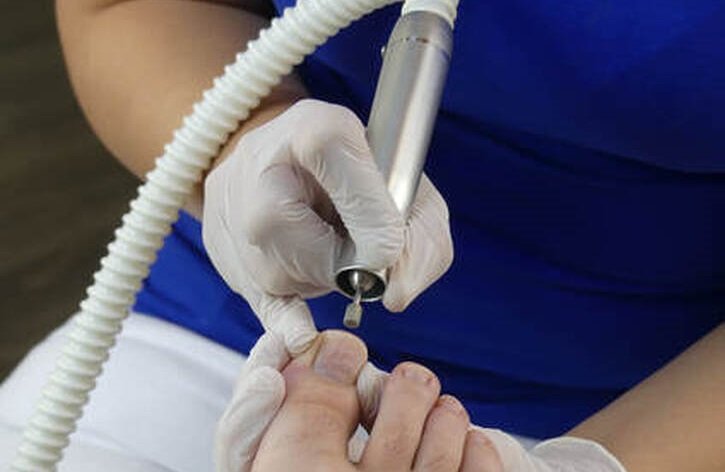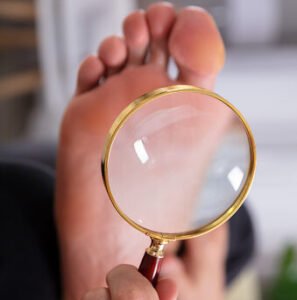Diabetic Foot Care
Diabetes and Your Feet
 In Canada, 1 in 4 adults over the age of 65 have diabetes. This is why diabetic foot care takes such high precedent in Canada. Diabetes affects many organs in the body, but can be particularly troublesome for the feet. Nerve damage called “neuropathy” can develop, which is uncomfortable and reduces sensation in your feet. Reduced blood flow to the feet negatively impacts healing and affects your immune system’s ability to fight off infection. Diabetes also causes foot deformities, which increases pressure on certain parts of the feet. All of these factors increase the risk of foot ulcer development. Infected foot ulcers are the leading cause of non-traumatic lower limb amputation in Canada.
In Canada, 1 in 4 adults over the age of 65 have diabetes. This is why diabetic foot care takes such high precedent in Canada. Diabetes affects many organs in the body, but can be particularly troublesome for the feet. Nerve damage called “neuropathy” can develop, which is uncomfortable and reduces sensation in your feet. Reduced blood flow to the feet negatively impacts healing and affects your immune system’s ability to fight off infection. Diabetes also causes foot deformities, which increases pressure on certain parts of the feet. All of these factors increase the risk of foot ulcer development. Infected foot ulcers are the leading cause of non-traumatic lower limb amputation in Canada.
This is precisely the reason for getting diabetic foot care from a chiropodist. Our chiropodist, Jake Cahoon, will assess your feet, safely cut your toenails and debride any hard skin. A diabetic foot assessment consists of 4 main categories:
- Vascular Status: Your pulses will be felt to determine if adequate blood flow is reaching your feet. A doppler ultrasound can be used in cases where pulses are not detectable. Signs of circulation like foot temperature, foot and leg swelling, capillary refill time, hair growth and skin integrity will be assessed.
- Nerve Function: Instruments such as a 10g monofilament and a 128hz tuning fork will be used to determine nerve function and your ability to detect sensation.
- Dermatologic Conditions: Skin and nail conditions are assessed. Nail problems such as curvy nails or ingrown nails can pose problems in those with diabetes and must be treated properly. Callus and corns are precursors for ulcer development and must be inspected and treated. Excessively dry skin can cause cracks in the skin. High moisture areas between the toes can pose risks for skin infection.
- Musculoskeletal Conditions: Deformities of the feet such as hammer toes or claw toes increase pressure points on feet which is a risk for ulcer development. Gait analysis is performed to see if there are any biomechanical issues. All the major foot joints are tested to determine range and quality of motion.
The information gained from all the above assessments allows the chiropodist to determine a “risk profile”. This guides how often you should be seen at our clinic, and what treatments need to be performed.
Diabetic Foot Advice
- Inspect Your Feet Daily –Check for cuts, blisters, redness, swelling or nail problems.
 Moisturize Your Feet Daily But Never Between Your Toes – Use a diabetic safe moisturizer daily to keep skin strong and to prevent cracks, but don’t moisturize between the toes as that area is already high in moisture.
Moisturize Your Feet Daily But Never Between Your Toes – Use a diabetic safe moisturizer daily to keep skin strong and to prevent cracks, but don’t moisturize between the toes as that area is already high in moisture.- Dry Between Your Toes – As just mentioned, between your toes is a high moisture area. If you don’t dry between your toes after bathing, the skin can become “macerated” (soggy) and prone to breakdown/infection.
- Do Not Treat Corns, Calluses or Ingrown Nails Yourself – No “bathroom surgery” or medicated pads. See your chiropodist for care.
- Wear Clean, Dry Socks – Change them daily.
- Specialized Socks – Diabetic socks are made to with non-elastic tops so they do not reduce blood flow. They also have extra cushion on the soles. Conversely, you may need compression socks, if determined by your doctor, to improve circulation and prevent swelling.
- Shake Out Your Shoes – Shake out your shoes before putting them on. Remember, your feet may not be able to feel a pebble or other foreign object. True story: I saw a circular lesion develping on one of my patient’s toes. Upon inspecting his footwear, out came his wedding ring he had lost months prior.
- Watch Out For Extreme Temperatures – You may not be able to detect extreme warm or cold with your feet. Always check bath water with your hands. Do not put your feet near a fire. Keep your feet warm and dry while walking outside in the winter.
- Do Not Walk Barefoot – This means at home too. Make sure you are wearing a home shoe or a substantial slipper with a hard sole.
- Control Your Blood Sugar Levels – Keeping your blood sugar under control prevents problems before they start! Check your blood sugar regularly. If you have troubles meeting your blood sugar targets, talk to your physician to discuss treatment options.
- Do not smoke. Smoking restricts blood flow in your feet.
- See your Chiropodist Regularly – It is important to have regular diabetic foot care and screening. If needed your chiropodist will also suggest things like custom orthotics, diabetic shoes, diabetic socks and give you other advice on how to care for your feet. Chiropodists are here to help you prevent foot complications due to diabetes.
